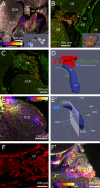iDISCO+ for the Study of Neuroimmune Architecture of the Rat Auditory Brainstem
- PMID: 30814937
- PMCID: PMC6381022
- DOI: 10.3389/fnana.2019.00015
iDISCO+ for the Study of Neuroimmune Architecture of the Rat Auditory Brainstem
Abstract
The lower stations of the auditory system display a complex anatomy. The inner ear labyrinth is composed of several interconnecting membranous structures encased in cavities of the temporal bone, and the cerebellopontine angle contains fragile structures such as meningeal folds, the choroid plexus (CP), and highly variable vascular formations. For this reason, most histological studies of the auditory system have either focused on the inner ear or the CNS by physically detaching the temporal bone from the brainstem. However, several studies of neuroimmune interactions have pinpointed the importance of structures such as meninges and CP; in the auditory system, an immune function has also been suggested for inner ear structures such as the endolymphatic duct (ED) and sac. All these structures are thin, fragile, and have complex 3D shapes. In order to study the immune cell populations located on these structures and their relevance to the inner ear and auditory brainstem in health and disease, we obtained a clarified-decalcified preparation of the rat hindbrain still attached to the intact temporal bone. This preparation may be immunolabeled using a clearing protocol (based on iDISCO+) to show location and functional state of immune cells. The observed macrophage distribution suggests the presence of CP-mediated communication pathways between the inner ear and the cochlear nuclei.
Keywords: 4th ventricle; auditory system; choroid plexus; cochlear nucleus; iDISCO+; inner ear; macrophage; microglia.
Figures


References
-
- Ahrens J., Berk G., Charles L. (2005). ParaView: An End-User Tool for Large Data Visualization. Elsevier: Visualization Handbook.
-
- Fuentes-Santamaría V., Alvarado J. C., Melgar-Rojas P., Gabaldón-Ull M. C., Miller J. M., Juiz J. M. (2017). The role of glia in the peripheral and central auditory system following noise overexposure: contribution of TNF-α and IL-1β to the pathogenesis of hearing loss. Front. Neuroanat. 11:9 10.3389/fnana.2017.00009 - DOI - PMC - PubMed
LinkOut - more resources
Full Text Sources
Miscellaneous

